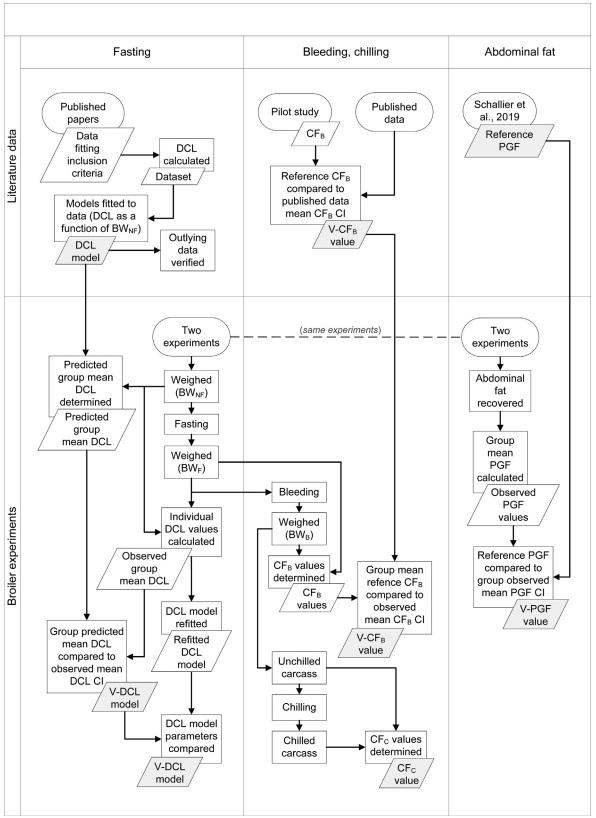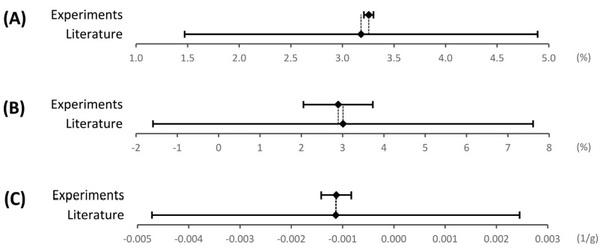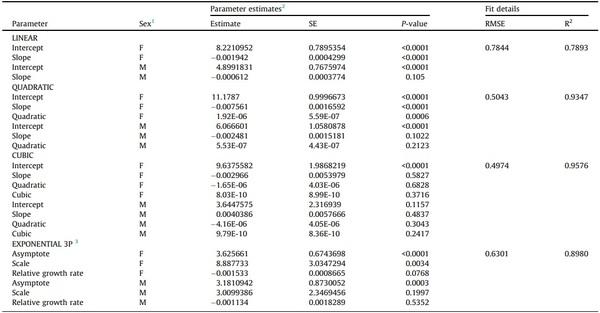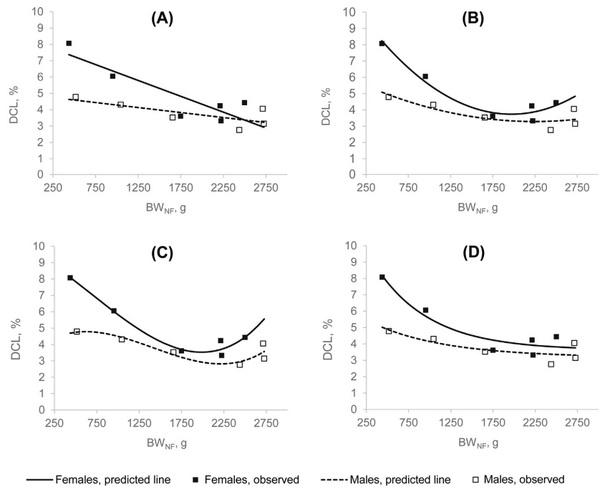Introduction
The poultry industry aims to increase the breast weight of broilers due to its higher market price. However, the breast size is associated with meat conditions such as woody breast (Maharjan et al., 2021a), the body protein turnover (Maharjan et al., 2020a, Maharjan et al., 2021b) and lean mass weight (Martinez et al., 2020a), and changes in the partitioning of the dietary energy (Martinez et al., 2019a). These relationships can be influenced to favor production and profit, as the breast weight (Martinez and Uculmana, 2016) and the factors above (Maharjan et al., 2021c) are sensitive to nutritional interventions.
The proper development of cost-effective nutritional (Maharjan et al., 2021c) and management (Martinez, 2012) strategies to maximize performance and breast growth depends on timing determinations (Quisirumbay-Gaibor et al., 2019) based on the dynamics of processing weights across the grow-out period, and on their interaction with genetics (Maharjan et al., 2020b), stress (Lyte et al., 2021a) and microbiota (Lyte et al., 2021b), skeletal integrity (Uculmana et al., 2018), and the intestinal potential to absorb nutrients (Martinez et al., 2019b) and their partitioning (Suesuttajit et al., 2022). Indeed, conducting longitudinal studies, testing the same individuals multiple times across the grow-out period, may allow more precise and accurate determinations and reduce the number of animals needed. Therefore, predicting the weights of the carcass and cut-up pieces represents an opportunity to develop this approach.
No method has been reported to provide accurate predictions of multiple cut-up pieces’ weights at extreme ages and weights of broilers (Martinez et al., 2022a). This manuscript is the first of a set of papers focused on using Dual-Energy X-ray Absorptiometry (DEXA) to determine the processing weights of broilers and its application to longitudinal nutrition studies. Two companion papers report the development (Martinez et al., 2022a) and validation (Martinez et al., 2022b) of prediction models.
Regardless of the predictors used in a prediction model, the birds need to be tested without fasting to show their normal response. Consequently, it is necessary to predict the fasted BW of the birds. In addition, the values obtained will require adjustments to correct the weights for the changes due to bleeding the birds and chilling the carcasses. Finally, the whole abdominal fat weight has been shown to predict the whole-body fat content (Becker et al., 1979). Therefore, the percent gizzard fat in the whole abdominal fat value will correct the error of models predicting the abdominal fat weight if the values are determined at a processing plant following a standard process, where most of the gizzard fat is lost (Martinez et al., 2022a). Therefore, the objective of this study was to develop and validate a model to predict the fasting weight loss of broilers as a function of the non-fasted BW, determine the weight changes due to bleeding and chilling, and assess the percentage of gizzard fat in the abdominal fat.
Material and methods
The general procedure followed in the study is presented in Fig. 1.
Literature data
Weight loss through fasting
An unrestricted literature search was conducted in Google Scholar using multiple keywords to gather papers published in scientific journals reporting weights before (BWNF; non-fasted BW) and after fasting (BWF; fasted BW) or their change. Papers used were those that accomplished all the following inclusion criteria: (1) fasted BW corresponded to that obtained after an actual fasting process, (2) reported data of both sexes, (3) fasting time was ≥ 12 hours, and (4) each data point agreed with the general trend (if data points were removed, their outlying character was verified as explained below). Data of the following variables were extracted: non-fasted BW (g), fasted BW (g), fasting time (hours), percent weight loss through fasting (DCL, %), and sex. When DCL was not reported in the paper, it was calculated as follows:


Fig. 1. General procedure. A model was developed to predict the digestive content loss correction factor (DCL; %) of broilers. The DCL model, a bleeding correction factor (CFB; %), and a percent gizzard fat in the abdominal fat (PGF; %) value were all validated (V-), taking into account their 95% confidence intervals (CI). A chilling correction factor (CFC; %) was determined. The non-fasted (BWNF) and fasted (BWF) BW were considered.
where DCL = digestive content loss (% BWNF) correction factor (%), BWNF = non-fasted BW (g), and BWF = fasted BW (g).
Weight loss through bleeding
After being contrasted with literature data, the blood loss (% BWF) correction factor (CFB, %) determined in a pilot study (Martinez et al., 2020b; CFB = 2.76%) was used as the reference CFB value. The literature search was conducted in Google Scholar using multiple keywords to gather papers published in scientific journals, reporting weights before and after bleeding or their change. Papers and their data were included if they reported values of broilers at 35 days of age (the midpoint of our critical age period: 1–70 days; Martinez et al., 2022a), assuming a constant blood loss rate across the range of ages in the study and similar for both sexes (Grey et al., 1982). The following data were extracted: fasted BW (g), bled BW (g), percent (% BWF) weight loss through bleeding (%). If not reported, CFB was calculated as follows:

where, CFB = blood loss correction factor (%), BWF = fasted BW (g), and BWB = bled BW (g). The reference CFB value was considered to agree with the literature data if the following criteria were met: the 95% confidence interval (CI95) of the mean literature data contained the reference value (implying no statistical difference; P > 0.05; Ramsey and Schafer, 2013), and the percent difference between the reference value and the literature mean value was ≤ 5% (applied if the literature sample size was ≤ 10).
Gizzard fat and abdominal fat
The gizzard fat and the abdominal fat (gizzard fat + fat pad) weights reported by Schallier et al. (2019) were used to calculate a reference value of the percent (%) gizzard fat in the abdominal fat (PGF, %), as follows:
where PGF = percent gizzard fat in the abdominal fat (%), GFW = gizzard fat weight (g), and AFW = abdominal fat (gizzard fat + fat pad) weight (g).
Modeling the fasting BW loss
Model fitting
Linear, quadratic and cubic polynomial, and exponential 3P models were fitted to the data obtained from the literature to determine the best fit, considering the BW as the predictor variable. Parameter estimates and their P values and CI95 were calculated for each model. The residual formula was saved as a new column in the table containing the raw data. The homoscedasticity of residuals was inspected visually, and their normal distribution with Shapiro-Wilk test (Inca et al., 2020). The evaluation criteria were the biological meaningfulness, the R2, and the RMSE values of the model (Inca et al., 2022).
Verification of excluded data
The residuals of the values excluded due to not agreeing with the general trend were calculated using the residual formula saved, even though they were not considered to fit the DCL model. All residuals (including those of excluded data) were examined to verify the outlying character of the excluded data points.
A total of 240 male Cobb-500 birds obtained from two experiments were used to validate the DCL model and the coefficients CFB and PGF obtained from literature data, and to determine the CFC coefficient. In both experiments, birds were raised in floor pens with wood shavings as litter material, a hanging tube feeder, and nipple drinkers. The pens were placed in solid-sided tunnel houses with automatic heating and ventilation systems. The birds were fed ad libitum corn-soybean meal pelleted diets formulated according to the genetic line recommendations and subjected to a dose-response design testing an exogenous enzyme. In both experiments, birds remained healthy and performed close to genetic standards across the grow-out period.
At 21, 35, 49, 63, and 70 days of age, 20 birds from each of the experiments (n = 200) were wing-tagged, weighted (BWNF), fasted for 12 hours, weighed again (BWF), and their DCL values were calculated per bird. Those birds obtained at 35 and 70 days (n = 80) were immediately brought to the University of Arkansas Pilot Processing Plant. Birds were slaughtered by cutting the jugular vein, bleeding for 90 s (Caldas-Cueva et al., 2021), dried with paper towels, and after being weighed again (BWB; bled BW), their CFB values were calculated. Once hanged back into the line and defeathered, the head, neck, and shanks were cut off, removing all viscera. The unchilled (‘‘hot”) carcass weights were recorded, and after a onehour rest on ice water, the chilled carcass weights were registered. The percent carcass weight increase through chilling (CFC; %) was calculated as follows:

where CFC = chilling (carcass weight % increase) correction factor (%), CARC = chilled carcass weight (g), and CARB = unchilled (‘‘hot”) carcass weight (g). At 42 days of age, 20 birds from each experiment (n = 40) were also processed and their carcasses followed through a semi-automatic evisceration process. The abdominal fat pad was manually extracted, the gizzard fat attached to the giblets was recovered, both weights were recorded, and the PGF was determined for each carcass.
Validations
Model for weight loss through fasting
Predicted DCL values were determined by entering the BWNF (n = 200) into the DCL model. Then, mean predicted DCL values were calculated for each of the ten groups of birds (2 experiments and five ages), and a single pooled mean DCL value was calculated per age (n = 5). Observed SD and CI95 values per age were calculated as the average of the corresponding values from both experiments. The pooled mean predicted DCL values were compared to the CI95 of the corresponding pooled mean observed DCL. Following Ramsey and Schafer (2013), the observed and predicted DCL data sets were considered not statistically different (P > 0.05) if the pooled mean predicted DCL value was within the CI95 of the corresponding observed one at each of the five ages (21, 35, 49, 63, and 70 days). Finally, the DCL model was refitted to the observed DCL data (n = 200). The new parameter estimates and their CI95 were compared with those from the DCL model fitted to literature data. No evidence or no conclusive evidence of difference (P > 0.05) was inferred if both or only one of the means fell within the CI95 of its counterpart, respectively (Ramsey and Schafer, 2013).
The DCL model was validated if no difference was inferred in the following comparisons: (1) between pooled mean predicted and observed DCL values at any of the five ages, and (2) between parameter estimates of the DCL model fitted to the literature or observed data.
Other correction factors
The CFB and PGF reference values used in the study were validated if they fell within the CI95 of the corresponding mean observed values.
Statistical analysis
Data tables were built up in Excel (Microsoft Excel version 2019; Microsoft Co., Redmond, WA) and JMP (JMP Pro 16; SAS Institute Inc., Cary, NC). Descriptive statistics and CI95 were calculated assuming a t-distribution as the mean ± the value obtained using the CONFIDENCE.T function of Excel. Data were plotted using Excel and the Graph Builder platform of JMP. Models were fitted to literature data using mean values reported in the literature with the Fit Curve platform of JMP, and relevant details, including the CI95 of parameter estimates of fitted models, were obtained from the Regression Reports option. The outlying character of the DCL values excluded from literature data was determined with the Robust Fit Outliers option of the Explore Outliers platform of JMP based on their distance to the predicted line (Cauchy distribution; K-Sigma = 1; Chen et al., 2021). Validations (DCL model and CFB and PGF values) were based on comparing the mean proposed values with the CI95 of the observed ones (Ramsey and Schafer, 2013).
Results
Literature data collected
Ten papers (Supplementary Table S1) were found reporting fasting BW loss values (93 rows; Supplementary Table S2). How ever, one reported data obtained by manually removing the digesta from euthanized birds (21 rows excluded), and six did not report data of both sexes (28 rows excluded). The dataset was reduced after removing rows corresponding to fasting times lower than 12 hours (26 rows excluded). Finally, after inspecting the graphical distribution of the data (BW on the X-axis; DCL on the Y-axis; Supplementary Fig. S1; script embedded in Supplementary Table S3), six rows were removed as no relationship with the trend of the rest of the data was observed. The final reduced dataset with 12 rows from two papers (Supplementary Table S2) included BWNF, BWF, and DCL values of broilers of both sexes at 15, 22, 29, 36, and 44 days of age (BWNF: 0.516 to 2.726 kg for males, 0.437 to 2.499 kg for females).
Twenty papers, including 28 data rows, reporting blood loss values were gathered. However, only four papers providing five data points met the inclusion criteria (Supplementary Table S4). The reference CFB value (2.76%) was not found to be different (P > 0.05) from the literature data as it was contained within their CI95 (2.31 to 3.28%; Supplementary Fig. S2; script embedded in Supplementary Table S5) and showed only a 1.6% difference with their mean (2.79%). A PGF value of 18% was calculated based on Schallier et al. (2019) data.
Modeling the fasting BW loss
The results of fitting alternative models to the DCL data are presented in Table 1. The models showing the highest R2 were the cubic and quadratic ones (0.96 and 0.93, respectively); the linear was the least precise (0.79), and the exponential 3P presented an intermediate R2 (0.90). However, the exponential model was the most biologically meaningful one, as both the quadratic and cubic models showed increasing values after reaching the axis of symmetry or a critical point, respectively, at high BW (Fig. 2). When those literature DCL data points excluded after a visual inspection (n = 6) were further inspected, their outlying character was confirmed (Supplementary Fig. S3; script embedded in Supplementary Table S3). Indeed, the residuals of the DCL model showed not only a normal distribution (P = 0.4916; Shapiro-Wilk test) but also a Cauchy one (P = 0.4868; Anderson-Darling test) (Supplementary Fig. S4; script embedded in Supplementary Table S6).
Table 1
Models fitted to data of fasting BW loss (DCL, %) of broilers as a function of BW.
1 F = Females; M = Males.
2 n = 12.
3 Exponential 3P model: DCL = a + b Exp (c BWNF); where, DCL = digestive content loss (% BWNF) correction factor (%), a = asymptote (minimum DCL value; %), b = scale (%), c = relative growth rate (constant for relative change in the DCL value; 1/g), BWNF = non-fasted BW (g).
Fig. 2. Fasting BW loss data of broilers from literature. (A) Simple linear, (B) quadratic polynomial, (C) cubic polynomial, and (D) exponential 3P models were fitted. The digestive content loss correction factor (DCL, %) was calculated as a function of the non-fasted BW (BWNF; g).
Table 2
Descriptive statistics of data obtained from broiler experiments.
1 Pooled values from two experiments are presented. n = 20 in each experiment and age.
Broiler experiments and correction factors
A summary of the data obtained from both experiments (n = 240 birds) is presented in Table 2 (detailed data in Supplementary Table S7). One hundred twenty birds provided data for DCL (at 21, 49, and 63 days), 80 for DCL, CFB, and CFC (at 35 and 70 days), and 40 for PGF (at 42 days). The observed and proposed correction factors and their validation are in Table 3. Broilers selected showed uniform age-wise BW (CV: BWNF ≤ 3.8%, BWF ≤ 3.9%, BWB ≤ 3.8%, chilled carcass ≤ 3.7%) and highly variable fat weights (CV: gizzard fat weight > 37%, fat pad > 26%). Consequently, the DCL and CFB showed uniform values (CV: ≤ 6.8 and 6.0%, respectively). The CFC and PGF showed higher variabilities (CV: > 22 and 18%, respectively). CFB, CFC, and PGF showed overall mean values of 2.75, 2.80, and 18.9%, respectively. All proposed values fell within the CI95 of the corresponding observed values and were therefore not statistically different (P > 0.05). Fig. 3 shows the parameter estimates of the DCL model refitted to data collected from broilers experiments compared to the one fitted to literature data (Supplementary Fig. S5, obtained through script embedded in Supplementary Table S8; plot built up in Supplementary Table S9). The scale and relative growth rate of the DCL model were considered not different (P > 0.05) between datasets (literature and broiler experiments), and the comparison of the corresponding asymptotes was inconclusive (percentual difference = 2.3%). The model refitted to broiler experiments data showed estimates with narrower CI95 associated with the higher sample size (n = 240 vs 12).
Table 3
Validation of correction factors with data obtained from broiler experiments.
1 DCL, percent weight loss through fasting (%); CFB, percent weight loss through bleeding (%); CFC, percent weight increase through chilling (%); PGF, percent gizzard fat in the abdominal fat (%).
2 Pooled mean values from two experiments. n = 20 in each experiment and age.
3 SEM was calculated using the pooled mean, SD, and n values from each experiment.
4 CI95, 95% confidence interval.
5 DCL proposed values for every age are means of the corresponding predicted ones, applying the exponential DCL model.
6 Proposed values were compared to the CI95 of the observed ones. NED = no evidence of difference (P > 0.05; Ramsey and Schafer, 2013) if the proposed value fell within the CI95 of the observed one.

Fig. 3. Parameter estimates of the digestive content loss correction factor (DCL, %) model (Exponential 3P one) fitted to literature data (‘‘Literature”; n = 12) compared to the corresponding ones obtained after refitting the model to data from broiler experiments (‘‘Experiments”; n = 240) based on their 95% confidence intervals (CI95; solid horizontal black line). Exponential 3P model: DCL = a + b Exp (c BWNF), where a = asymptote (minimum DCL value; %), b = scale (%), c = constant for relative growth rate (1/g), and BWNF = non-fasted BW. Model refitted to Experiments data: a = 3.255, b = 2.892, and c = -0.001124 (R2 = 0.7436; RMSE = 0.2062; Supplementary Fig. S5). Model fitted to Literature data: a = 3.181, b = 3.010, and c = -0.001134 (R2 = 0.8980; RMSE = 0.6301; details in Table 1). No evidence or no conclusive evidence of difference (P > 0.05) were inferred if both or only one of the estimates (black diamonds) fell (vertical dashed lines) within the CI95 of its counterpart, respectively (Ramsey and Schafer, 2013). Horizontal sections (A), (B), and (C) compare the asymptotes, scales, and relative growth rates, respectively.
Author’s point of view
In this study, we sought to model the fasting BW loss based on the BWNF, as well as to assess the changes in weights due to bleeding and chilling, and determine the percentage of gizzard fat in the whole abdominal fat. Based on the observed results, the three-parameter exponential DCL model developed herein (showing declining DCL values as the bird weight increases) and the tested CFB (2.76%) and PGF (18%) coefficients fulfilled the criteria and were all validated. In addition, the mean CFC value determined (2.79%) was in agreement with that reported by Wang et al. (2020; 3.00%). Consequently, no disagreement between these findings and current knowledge has been found.
Some assumptions made in this study may be further tested as more data become available. First, we considered the set of papers collected providing fasting BW loss data a good enough random sample. Then, a constant blood loss rate across the range of ages in the study and similar for both sexes was assumed according to Grey et al. (1982) data. Finally, based on the high correlation coefficients between gizzard fat (0.89) or abdominal fat pad (0.96) and DEXA-reported fat mass in broilers of different ages reported by Schallier et al. (2019), we assumed a constant ratio of gizzard to the abdominal fat pad as the bird aged.
Validating the DCL model considering the overlap of CI95 is a reliable approach as the model’s primary purpose was to account for the influence of the BWNF. This approach has been reviewed (Cumming and Finch, 2005) and applied for multiple purposes (Martinez et al., 2020c; Martinez, 2021).
We consider the difference between datasets (literature and broiler experiments) in the asymptote of the DCL exponential 3P model (2.3%) small enough to be negligible. The predicted DCL of a 42-day-old broiler with 3,100 g BW would be 3.17% BWNF (98.3 g) or 3.24% BWNF (100.4 g) if calculated with the model fitted to data from the literature or the experiments, respectively. Such a difference in BW loss (2.1 g) equals only 0.07% of the BW.
Currently, the processing weights are used as response variables at the end of the studies. Given the higher relevance the breast yield of modern genetic lines is gaining through the years, the interest of the industry and academia to focus on the dynamics of processing weights across the grow-out period will keep increasing. The model and coefficients obtained herein may not only be applied to develop models to predict processing weights using DEXA equipment (Martinez et al., 2022a; Martinez et al., 2022b) but also any type of predictor variables. In addition, the raw data may favor meta-analysis, other modeling approaches, and simulation studies having available a ‘‘seed” data sample.
Finally, the percent gizzard fat in the abdominal fat obtained in this study will favor better use of published data to predict the body fat weight and determine the dietary energy retention.
Conclusion
In conclusion, the fasting weight loss (DCL) shows declining values as the BW increases across the grow-out period. A three-parameter exponential DCL model describing this relationship has been developed and validated. Correction factors to adjust the weights for the changes due to bleeding the birds and chilling the carcasses have been validated and determined, respectively. Finally, a reference value of the percent gizzard fat in the whole abdominal fat value has been validated. This model and correction coefficients may favor further modeling efforts to approach better the growth dynamics of the processing weights of broilers.

























